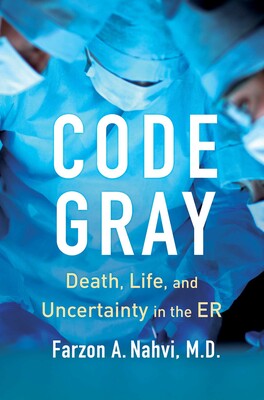Code Gray: Death, Life, and Uncertainty in the ER
- By Farzon A. Nahvi, M.D.
- Simon & Schuster
- 256 pp.
- Reviewed by Tania Heller
- March 30, 2023
A physician pulls back the curtain on emergency medicine.

The compelling memoir Code Gray by emergency room physician Farzon A. Nahvi offers a transparent and thought-provoking account of the intense pressure, tragedy, ethical dilemmas, and uncertainty that ER doctors face in the course of their duties.
The prologue provides a rare, behind-the-scenes look at the informal, real-time communication among some of them at the onset of the covid-19 pandemic. It gives readers insight into physicians’ vulnerability and the lack of clear direction for healthcare professionals during a period when they were seeing not only patients, but their own friends, relatives, and colleagues succumb to the virus, too.
Nahvi’s book focuses primarily on the pre-covid story of a woman who is brought to the ER after suffering a cardiac arrest. With as much sensitivity as possible given the circumstances, the author recounts in detail the ensuing events that unfold, including the medical team’s attempt at resuscitating the patient, followed by the doctor’s emotional communication with the now-deceased woman’s spouse and the eventual discovery of the likely cause of death.
As the author tells of attempting to save a life, he reflects on his thinking at the time, in the process reminding readers that practicing medicine encompasses more than treating disease. It requires effective communication and sometimes difficult conversations. More broadly, Code Gray offers an inside look at the high-pressure environment in the emergency room — which predates the pandemic — and draws attention to the fact that medicine, even with technological advancements, is far from precise.
Nahvi also reminds us that underneath their often calm demeanor, healthcare workers, like everyone else, experience strong emotions when confronted with distressing situations. Unfortunately, many struggle to deal with these emotions:
“So, unable to adequately communicate our experiences, we often stop trying to communicate them altogether. Counterintuitively, it is the very magnitude of their importance that might be the cause of our failure to address them.”
Nahvi includes several interesting and disturbing anecdotes, including that of a patient with unexpected findings on a CT scan, another with confusion resulting from alcohol-induced liver damage, and even one who arrived at the ER every Fourth of July simply for refuge. He also describes a situation in which a cancer patient came to the emergency room seeking chemotherapy after losing her health insurance. Here and elsewhere, he illustrates the frustration of trying — and sometimes failing — to do what’s best for patients given the shortcomings of America’s healthcare system.
Although Nahvi doesn’t offer us answers when recounting these painful, discomfiting stories, he invites the reader to explore alongside him what makes us uneasy, to welcome a degree of uncertainty, and to appreciate the beauty in our lives.
“I believe it is worth seeing our strange and uncomfortable experiences for what they are,” he writes. “It is only through acknowledging our discomforts that we can sort through our thoughts and understand our world in a more meaningful way.”
Code Gray succeeds in opening our eyes to the mentally and physically demanding work of an ER physician, as well as to both the limitations of modern medicine and to the humanity found within it. The book may also leave readers wondering who is caring for those selfless enough to take on the responsibility of caring for us.
Tania Heller, M.D., is an independent medical school admissions consultant and the author of several books, including On Becoming a Doctor (Sourcebooks) and You and Your Doctor (McFarland).

